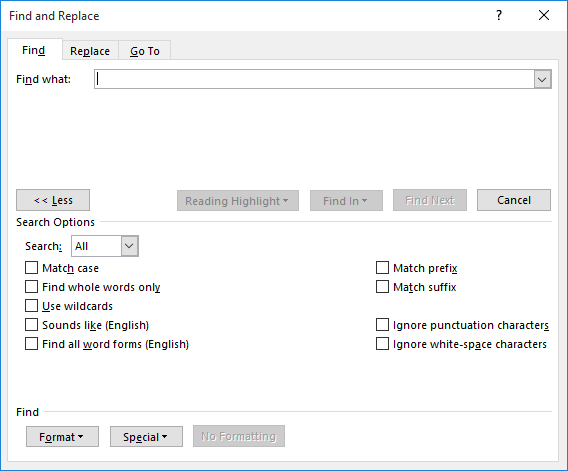Please Note: This article is written for users of the following Microsoft Word versions: 2007, 2010, 2013, 2016, 2019, 2021, and Word in Microsoft 365. If you are using an earlier version (Word 2003 or earlier), this tip may not work for you. For a version of this tip written specifically for earlier versions of Word, click here: Special Differences when Searching.
Written by Allen Wyatt (last updated March 5, 2022)
This tip applies to Word 2007, 2010, 2013, 2016, 2019, 2021, and Word in Microsoft 365
Word includes a powerful search feature that allows you to find information based on just about every conceivable condition. As covered in other issues of WordTips, you can even use wildcards (Word's term for what programmers call regular expressions) in your searching. Here's a tip you may not have known, however.
First, start by displaying the Find tab of the Find and Replace dialog box. (This could just as easily apply to the Replace tab but working with the Find tab will illustrate the point.) If the More button is available, click it so that the dialog box is expanded. (See Figure 1.)

Figure 1. The expanded Find tab of the Find and Replace dialog box.
When you use the normal search capabilities of Word (in other words, the Use Wildcards check box is not selected), the Special button at the bottom of the dialog box displays different special characters for which you can search. If you do a wildcard search (the Use Wildcards check box is selected), the options available when you click on Special are changed to reflect the special needs of using wildcards in your searching.
Why is this a big deal? Because along with the power available by using wildcards in your searching comes additional complexity. Sometimes it is hard to remember the meaning of the different special wildcard characters. Remembering that the Special button displays the necessary characters helps make using wildcards easier.
WordTips is your source for cost-effective Microsoft Word training. (Microsoft Word is the most popular word processing software in the world.) This tip (2076) applies to Microsoft Word 2007, 2010, 2013, 2016, 2019, 2021, and Word in Microsoft 365. You can find a version of this tip for the older menu interface of Word here: Special Differences when Searching.

Do More in Less Time! An easy-to-understand guide to the more advanced features available in the Microsoft 365 version of Word. Enhance the quality of your documents and boost productivity in any field with this in-depth resource. Complete your Word-related tasks more efficiently as you unlock lesser-known tools and learn to quickly access the features you need. Check out Microsoft 365 Word For Professionals For Dummies today!
When you use Word's Find and Replace capability, clicking the Replace button performs the replacement and automatically ...
Discover MoreThe Find and Replace capabilities of Word are quite powerful. Knowing how to find and replace highlighted text can be a ...
Discover MoreThe Find and Replace tool is designed to help you find and replace information as quickly as possible. However, you may ...
Discover MoreFREE SERVICE: Get tips like this every week in WordTips, a free productivity newsletter. Enter your address and click "Subscribe."
There are currently no comments for this tip. (Be the first to leave your comment—just use the simple form above!)
Got a version of Word that uses the ribbon interface (Word 2007 or later)? This site is for you! If you use an earlier version of Word, visit our WordTips site focusing on the menu interface.
Visit the WordTips channel on YouTube
FREE SERVICE: Get tips like this every week in WordTips, a free productivity newsletter. Enter your address and click "Subscribe."
Copyright © 2026 Sharon Parq Associates, Inc.
Comments